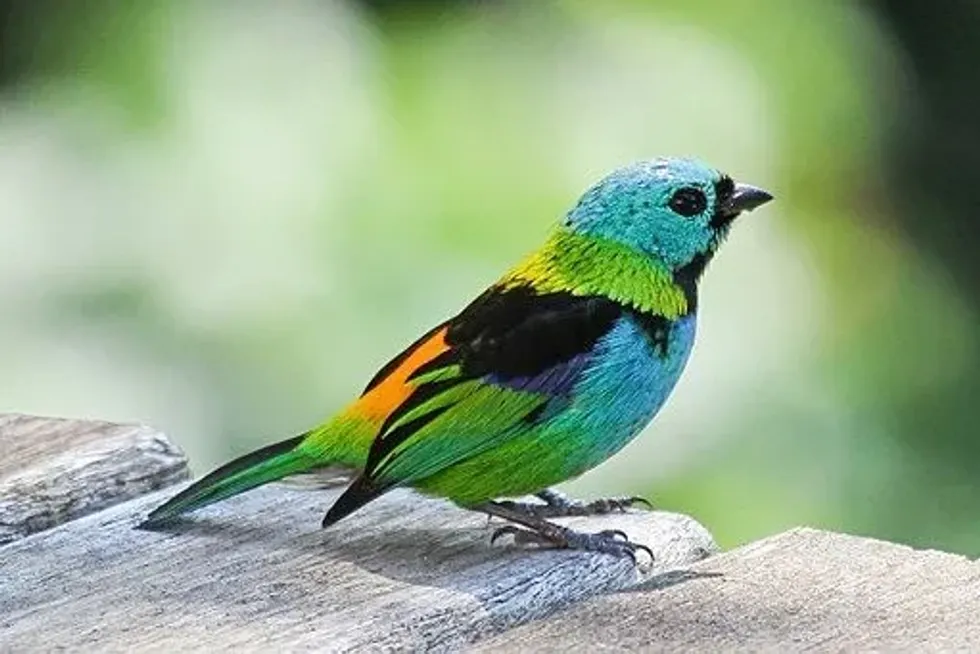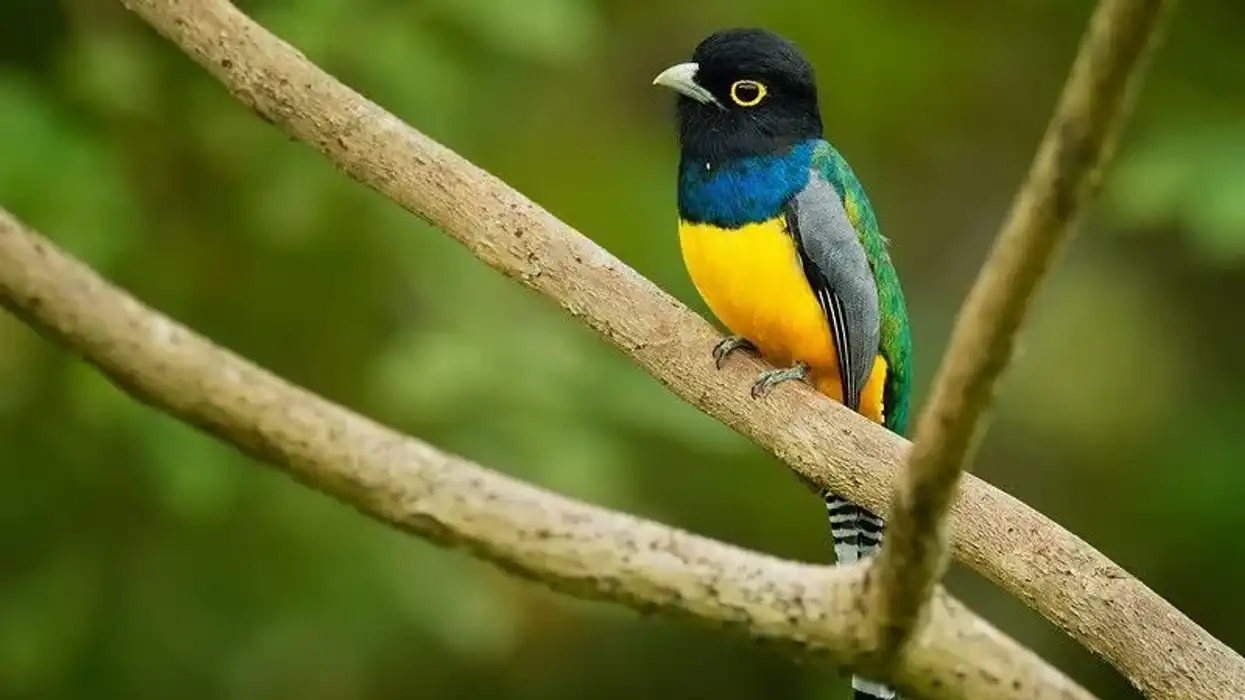The green-headed tanager (Tangara seledon) is a South American medium-sized bird belonging to the Thraupidae family, genus Tangara. This bird is found in the Atlantic forest region in the far north of the continent.
This green-headed bird is usually found at a higher elevation and is seen perching on top of trees. Their bright blue-green coloration helps in camouflaging them within the colorful foliage of their habitat. It is mostly restricted within its range but can be found moving elsewhere depending on the season.
Like most other small birds, this bird is also extremely active and playful. They hop along branches and peck at the sides of trees in the forests while foraging for fruits and insects.
Their unique bill aids them in removing the seeds from fruit. They are also expert fliers and can be seen performing acrobatic movements while moving from one branch to another.
This bird is also known as Sete Cores in the local Portuguese language in Brazil, Paraguay, and Argentina. In English, ;Sete Cores' translates to 'seven colors;, indicating the colors of the bird's feathers.
Keep reading for more amazing facts about the green-headed tanager! If you liked this article about the green-headed tanager, also check out our other articles with interesting facts about the summer tanager and greenish warbler.
Green-Headed Tanager Interesting Facts
What type of animal is a green-headed tanager?
The green-headed tanager (Tangara seledon) is a type of bird.
What class of animal does a green-headed tanager belong to?
The green-headed tanager (Tangara seledon) belongs to the Aves class of animalia and the family of Thraupidae.
How many green-headed tanagers are there in the world?
The population of the green-headed tanager bird species has not yet been estimated by scientists. However, their population is considered to be stable and confined to a few protected areas as deforestation affects them negatively.
Where does a green-headed tanager live?
The green-headed tanager (Tangara seledon) is found in the South American countries of Brazil, Paraguay, and Argentina. These birds are not very widely spread and are only found in certain regions in the far north of Brazil, Argentina, and Paraguay.
What is a green-headed tanager's habitat?
The green-headed tanager (Tangara seledon) inhabits the tropical, moist, and humid forests of the Atlantic forest in South America. The Atlantic forest is also filled with tropical and subtropical grasslands, shrublands, and mangrove forests. Apart from that, these birds are also common in orchards and parks.
Who do green-headed tanagers live with?
This bird species is quite social. They can be seen roaming around and foraging in small flocks comprising of 10-20 birds. They may also roam around in mixed flocks with other bird species within the same habitat of Brazil, Paraguay, and Argentina.
How long does a green-headed tanager live?
The exact lifespan of the green-headed tanager (Tangara seledon) has not yet been recorded by scientists and researchers. However, based on the lifespan of other tanager birds, it can be assumed that these birds have a lifespan of 12-17 years.
How do they reproduce?
The breeding season of this species takes place between November to February in Brazil, November, and December in Paraguay, and November in Argentina. The monogamous mating pair builds a nest that looks like a heavy cup. The nest is built by both male and female birds with grasses and leaves. They hide the nest within thick vegetation or foliage.
Each clutch consists of two to three pink-white eggs and the incubation period lasts for 13-14 days. The chicks start to fledge around two weeks after hatching. The young offspring depend on their parents for a long time even after fledging.
What is their conservation status?
The International Union for Conservation of Nature (IUCN) has listed the green-headed tanager (Tangara seledon) under the Least Concern category in its IUCN Red List.
Green-Headed Tanager Fun Facts
What do green-headed tanagers look like?
The green-headed tanager has an extremely colorful combination of plumage consisting of six to seven different colors. Their plumage has an opalescent quality and it glows under special light.
The male bird has a turquoise-colored head and neck. They have a yellow-colored band around their neck and their back is black in color.
Their chest is light blue while their lower back is bright orange in color. They seem to be sporting a small black-colored bib and their belly is turquoise blue or green in color. The female and young birds are not as bright in color but are paler and greener.
How cute are they?
The green-headed tanager is an extremely cute bird. Its brilliant and bright-colored feathers along with its small size make it one of the most beautiful birds in the region.
How do they communicate?
These birds mostly use sound to communicate with each other. They have a unique call that they use during courtship or when they need to warn others of danger.
How big is a green-headed tanager?
The average length of a green-headed tanager is 5.3 in (13.5 cm). A hyacinth macaw is almost 10 times the size of a green-headed tanager as it can grow up to 39.4 in (100 cm) size.
How fast can a green-headed tanager fly?
While the exact speed of this bird during flight is not known, the green-headed tanager flying speed has been noted to be pretty fast.
How much does a green-headed tanager weigh?
The average weight of a green-headed tanager bird is 0.6-0.7 oz (16-20 g).
What are the male and female names of the species?
Male and female birds are referred to as cocks and hens respectively. The species of this bird will be referred to as the same.
What would you call a baby green-headed tanager?
A baby bird of this species does not have a separate, distinct name. Therefore, it is usually referred to as a chick or nestling.
What do they eat?
The diet of this species primarily consists of fruits. They also eat nectar, seeds, and insects. They can also be found near bird tables or bird feeding stations which are common in orchards and parks.
Are they dangerous?
This bird species is not known to be dangerous or harmful to humans or other animals in the forest.
Would they make a good pet?
Keeping a green-headed tanager pet would not be a good idea. This bird species prefers its usual range of wild habitat that it can find in the Atlantic forest in Brazil, Argentina, and Paraguay, unlike Fischer's lovebird.
Did you know...
They also contribute to their local habitat by helping in the pollination of local flowers found in the Atlantic forest. This happens while they reach into the flowers to extract nectar.
What do green-headed tanagers sound like?
The green-headed tanager species is known for making loud, tri-syllabic, high-pitched sounds during the time of dawn from the top of a tree. Their call sounds like 'sir sir sweet' and it is a combination of buzzy 'zweet' sounds along with rapid twittering notes like 'zwee-di-di-di'.
What is the green-headed tanager's wingspan?
The exact length of the wingspan of this bird has not yet been recorded. However, based on the wingspan of other tanager birds like the scarlet tanager, summer tanager, and western tanager, it can be assumed that the length of the wingspan of this bird is around 9.8-11.4 in (25-29 cm).
Here at Kidadl, we have carefully created lots of interesting family-friendly animal facts for everyone to discover! For more relatable content, check out these rufous-crowned sparrow facts and common grackle facts for kids.
You can even occupy yourself at home by coloring in one of our free printable green-headed tanager coloring pages.









